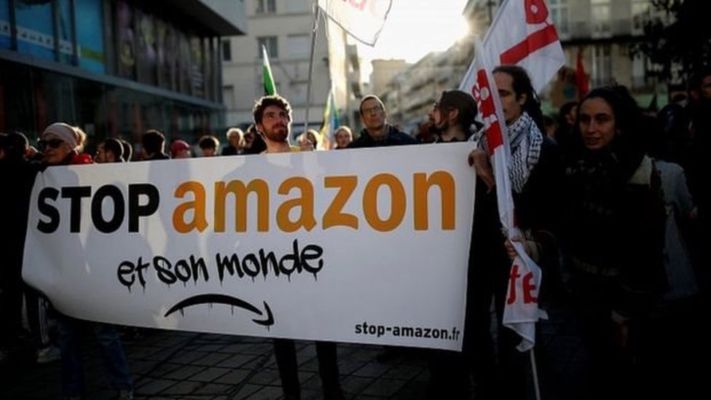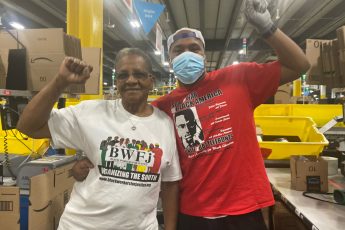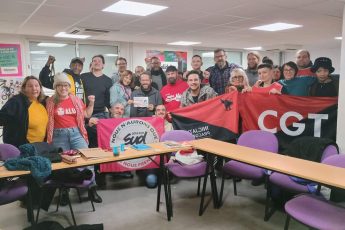
By PRECARIOUS CONNECTIONS (Italy)
On Monday 22th March, in Italy the first national strike against Amazon will take place, involving the entire supply chain of those who work in and for the Seattle-based giant. The strikes against Amazon, however, are not new and take place within a sector marked by a long and hard cycle of struggles. For several years now, workers of the Seattle-based giant have been striking during every Black Friday, Prime Day and Christmas peak. For years, they have been making their voices heard, demanding higher wages and better working conditions. For years, they have been meeting in transnational meetings of Amazon Workers International to converge towards a common strategy, even though their national situations are very different. For this reason, we are not among those who look at the national strike against Amazon as an absolute “first”, because even in the Italian warehouses, and especially in Piacenza, they have been stubbornly fighting for years.
The national strike is a significant novelty because it involves all the different figures working in Amazon’s supply chain
Nonetheless, we are certainly among those who were looking forward to it, because we know that those struggles often carried out in solitude and in prohibitive conditions needed something like this. That is why we think that the national strike should be considered a significant novelty, not only because of its territorial scale, but because it involves all the different figures working in the Amazon supply chain – sorting and storage workers, drivers, security workers – in an overall rejection of the working conditions imposed by the algorithm. It is an important moment in the transnational struggle against Amazon. This strike, like others that are going on in the logistics sector, is not a measure of the strength of the unions that are calling for it, nor is it an episode, however interesting, in an Italian comedy. Only if we place and understand it on the long road to Seattle, it helps us to understand where we are, how far we can go, what possibilities and spaces for struggle and organization it opens up.
It is therefore necessary to reconstruct what made it possible, looking beyond Italy once again, and going back to a year ago, when, in the first weeks of the pandemic, factories and logistics warehouses all over the world were crisscrossed by the protests of workers who refused to produce profit for those who, by declaring them essential, exposed them to contagion. In Italy, a series of spontaneous strikes and abstentions from work affected the Amazon warehouses in Torrazza (Turin) and Passo Corese (Rome), but above all the one in Piacenza, where the strike lasted eleven days and forced the company to introduce anti-infection sanitary measures. In Amazon’s warehouses in Poland, France, Spain and the United States, that refusal soon gained strength on an unprecedented scale, forcing Amazon to recognise a wage increase in all its warehouses, and managing to connect and communicate between different countries. This happened also and above all thanks to the network of Amazon Workers International. Amazon on one side and all the workers on the other have emerged clearly as the two opposing fronts of a transnational struggle. A clash that in the United States has led to Amazon’s attempt to impose a 10-hour night ‘mega-shift’, but also to the first vote to unionise a warehouse in Alabama, which promises to have knock-on effects nationwide and beyond.
This qualitative leap in transnational organisation has fostered the spread of organisational processes at national and local level, especially in Italy, where the last year has seen, in parallel with the opening of new centres, the unionisation of many warehouses in which, until before the pandemic, any trade union initiative was almost unthinkable. The desire to strike, which has grown in sites throughout Europe and the United States, has ended up affecting the traditional unions themselves, which until last Black Friday had tried to argue that striking was inappropriate given the time of emergency. A few months later, the national strike signals that something from the shop floor has broken through the walls erected by unions’ officials and bureaucrats. In the space of a few months, the traditional unions have had to adapt their own internal organisation to the nature of the Seattle-based giant, with the creation of national cross-sector coordinations. They had to realise that Amazon cannot be challenged based on 20th century industrial relations etiquette. With more than 40,000 employees in a myriad of contractual and wage situations, in logistics, commerce and transport, in direct employment, contracting and subcontracting, it is impossible to use the collectively binding nature of national sectoral agreements, on which the union structure itself is based, against Amazon. Thus, the traditional unions had to recognise the political centrality of the battle within Amazon as the master of a huge chunk of the working class in Italy.
Therein lies the political novelty of the national strike: in the effort to unite the conditions that Amazon tries every day to fragment and disperse, but which are all subjected to the same unsustainable rhythms, loads and working hours established by the algorithm through the mechanism that controls productivity. By measuring in detail, the time of each individual movement of the worker (both within the warehouse and during the delivery), the algorithm classifies workers according to their productivity and dictates an average that must be respected, without informing anyone of his own individual productivity. At the same time, individual productivity determines the possibility of employment for temporary workers, who therefore try to work as fast as possible to stay above the average. With the vast majority of Amazon’s employees in Italy (between 70 and 80%) hired on a temporary basis and with precarious contracts, this mechanism produces a constant increase in the overall average productivity and work rhythms, and thus an accelerated wear on health. It is because of this blackmail that Amazon can guarantee above-average wages, while brutally making their recipients pay the price for it.
Bringing together the positions of all those who suffer its consequences, the national strike of March 22nd will be a general strike against the blackmail of the algorithm, a collective rejection of the brutal command it imposes on work and on existences. A refusal not only on the part of those who work in warehouses and have to endure an iron discipline, stiffened by an instrumental use of anti-contagion rules, but also on the part of couriers who see the number of daily deliveries constantly increasing, and thus the risk of accidents, as the rebellion of the drivers in Pisa at the end of February showed. Not only on the part of Amazon’s direct employees, but also of those from the countless sub-contracting companies, such as the ICTS employees who went on strike in October in Turin, paid half as much as their colleagues with whom they share workplace and tasks. Not only on the part of workers with permanent contracts, but also of temporary workers who are preferred for being easily blackmailed.
This strike will be a step forward on the road to Seattle only if it is not reduced to a model dispute that ends with and within Amazon.
So finally, the strike! Finally, a strike that connects all these different workers, not only to demand better conditions today, but also to lay the foundations for a more solid organisation in the long term, which will only be possible by attacking the productivity spiral imposed by the algorithm. However, this national strike will be a step forward on the road to Seattle only if it is not reduced to a model dispute that ends with and within Amazon, and only if it comes to terms with the fact that the conditions imposed by Amazon spill over to the outside world. That means that the blackmail of the algorithm affects the entire logistics sector, increasing the pace and worsening working conditions in all companies that want to stay on the market. These are the hubs and warehouses that have been hit in recent years by a cycle of struggles in which migrant workers have been at the forefront, and which are currently hit by unprecedented repression, as shown by the sentences passed against migrant workers and Sicobas trade unionists in Piacenza. These are the warehouses where more and more refugees are employed with on-call contracts, where female workers are imposed shifts that make it impossible to manage children and have a life outside work. These warehouses will be on strike on March 26th, together with the riders of the delivery platforms, in turn demanding a reduction in work rhythms and hours, as well as greater protection for their health damaged by excessive loads. The strike of March 22nd will be a step forward on the road to Seattle only if it does not become the prologue to a new social pact, in which better conditions for some will translate into greater exploitation for others, and in which the spotlight on Amazon allows everything else to remain in the shadow. This strike is not only against Amazon. Taking up a French slogan from a few years ago and, turning it also against the intentions of the unions who called the strike, this general strike must become a strike against Amazon and its world.





